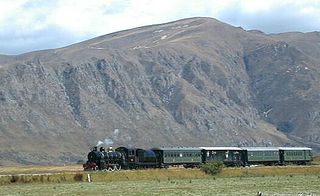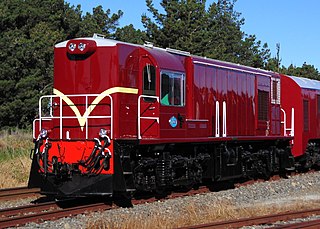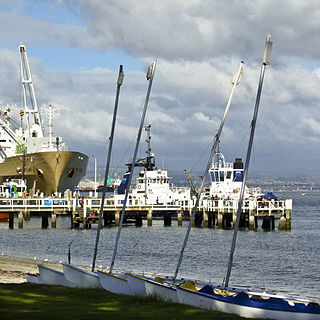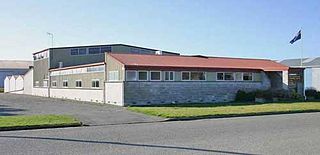
Rail transport in New Zealand is an integral part of New Zealand's transport network, with a nationwide network of 4,128 km of track linking most major cities in the North and South Islands, connected by inter-island rail and road ferries. Rail transport in New Zealand has a particular focus on bulk freight exports and imports, with 19 million net tonnes moved by rail annually, with 99.5% of New Zealand's exports and imports being transported through the country's seaports.

The Kingston Flyer is a vintage steam train in the South Island of New Zealand at the southern end of Lake Wakatipu. It used 14 kilometres of preserved track that once formed a part of the Kingston Branch. Originally, Kingston Flyer was a passenger express train between Kingston, Gore, Invercargill, and less frequently, Dunedin. It was operated by the New Zealand Railways (NZR) from the 1890s to 1957. In 1971, NZR revitalised the service as a tourist venture, later leasing the locomotives and rolling stock in 1982 to a private company. Since then, the Kingston Flyer has been through a number of owners, most recently being owned by the Kingston Flyer Ltd. The company intends on restarting operations in Summer 2020.

Sir Ian Charles Athfield was a New Zealand architect. He was born in Christchurch and graduated from the University of Auckland in 1963 with a Diploma of Architecture. That same year he joined Structon Group Architects, and he became a partner in 1965. In 1968 he was a principal partner in setting up Athfield Architects with Ian Dickson and Graeme John Boucher (Manson). Athfield died in 2015 due to complications from a routine procedure which resulted in pneumonia, at the Wellington Hospital, where he was being treated for prostate cancer.

The Main South Line, sometimes referred to as part of the South Island Main Trunk Railway, is a railway line that runs north and south from Lyttelton in New Zealand through Christchurch and along the east coast of the South Island to Invercargill via Dunedin. It is one of the most important railway lines in New Zealand and was one of the first to be built, with construction commencing in the 1860s. At Christchurch it connects with the Main North Line to Picton, the other part of the South Island Main Trunk.

The New Zealand DI class locomotive was a class of diesel-electric locomotive in New Zealand. They were built by English Electric Australia. The class is very similar to the Queensland Railways 1620 class locomotives. At the time of their introduction, the class was seen as an alternative to the DB class for use on lightly laid secondary and branch lines, more so in the South Island, however the World Bank financed introduction of the Japanese built DJ class in 1968 ensured that no further DI class locomotives were purchased by New Zealand Railways.

SLI Systems provided cloud-based search tools for online retailers under a "software as a service" (SaaS) model. It was a public company listed on the New Zealand stock exchange.

Invercargill Passenger Transport Ltd was a bus company which operated public transport routes in Dunedin and Invercargill as well as school transport services in those cities as well as Queenstown and leisure and tourism transport services throughout the South Island of New Zealand

The Port of Tauranga is situated in Tauranga, New Zealand. It is the largest port in the country both in terms of total cargo volume, and in terms of container throughput with container volumes exceeding 950,000 TEUs. The port is operated by Port of Tauranga Ltd. This article is about both the company and the port itself.

Tip Top is a New Zealand ice cream brand owned by Froneri, but was formerly Fonterra Brands Ltd, a subsidiary of the Fonterra Co-operative Group based in Auckland, New Zealand.
KiwiRail Holdings Limited is a New Zealand state-owned enterprise responsible for rail operations in New Zealand, and operates inter-island ferries. Trading as KiwiRail and headquartered in Wellington, New Zealand, KiwiRail is the largest rail transport operator in New Zealand. KiwiRail has business units of KiwiRail Freight, The Great Journeys of New Zealand and Interislander. KiwiRail released a 10-Year Turn-around Plan in 2010 and has received significant government investment in support of this in an effort to make KiwiRail a viable long-term transport operator.
Mark Rhys Weldon is a New Zealand businessman and swimmer.
Brierley Investments Limited (BIL) was established by New Zealand investment veteran Sir Ron Brierley in 1961 and in 1985 listed on stock exchanges in Australia, United Kingdom, and New Zealand. It grew to become one of the biggest – and for a time most successful and glamorous – companies in the 1980s. At its peak about 150,000 New Zealanders were BIL shareholders.

Xero is a New Zealand domiciled public technology company, listed on the Australian Stock Exchange. Xero is a cloud-based accounting software platform for small and medium-sized businesses. The company has three offices in New Zealand, six offices in Australia, three offices in the United Kingdom, three offices in the United States, as well as offices in Canada, Singapore, Hong Kong and South Africa.

The South Island Organ Company is a manufacturer of pipe organs in Timaru, New Zealand. The company, in business since 1968, has manufactured and restored over 300 pipe organs throughout New Zealand, Australia and Oceania.
The NZX 50 Index (NZ50) is the main stock market index in New Zealand. It comprises the 50 biggest stocks by free-float market capitalisation trading on the New Zealand Stock Market (NZSX). The calculation of the free-float capitalisation excludes blocks of shares greater than 20% and blocks between 5% and 20% that are considered strategic.
Vista Group International Limited provides film industry technology for studios, distributors, exhibitors, and moviegoers globally.
Pacific Edge Limited is a cancer diagnostics New Zealand company that offers a genetic biomarker based suite of bladder cancer diagnostic tools. The company has offices in Hershey, USA, and its head office in Dunedin, New Zealand. Pacific Edge is listed on the New Zealand NZX main board stock exchange under ticker code PEB, and forms part of the NZX 50 Index.
The 1991 New Year Honours in New Zealand were appointments by Elizabeth II on the advice of the New Zealand government to various orders and honours to reward and highlight good works by New Zealanders. The awards celebrated the passing of 1990 and the beginning of 1991, and were announced on 31 December 1990.











